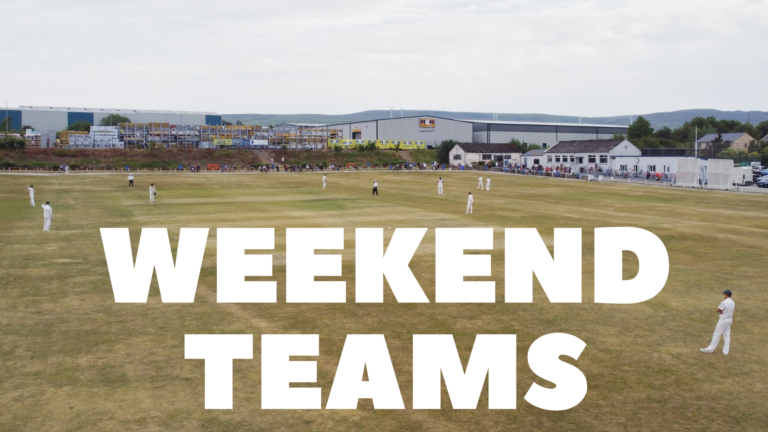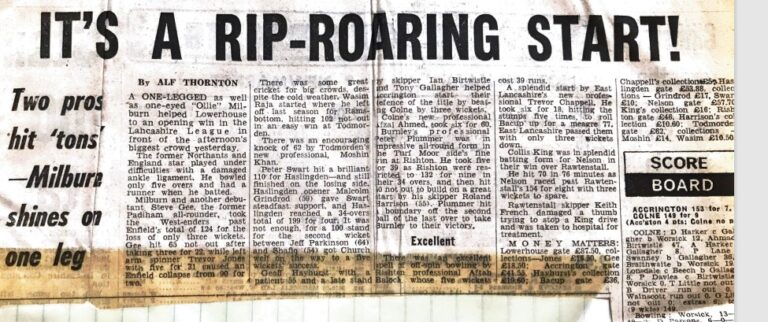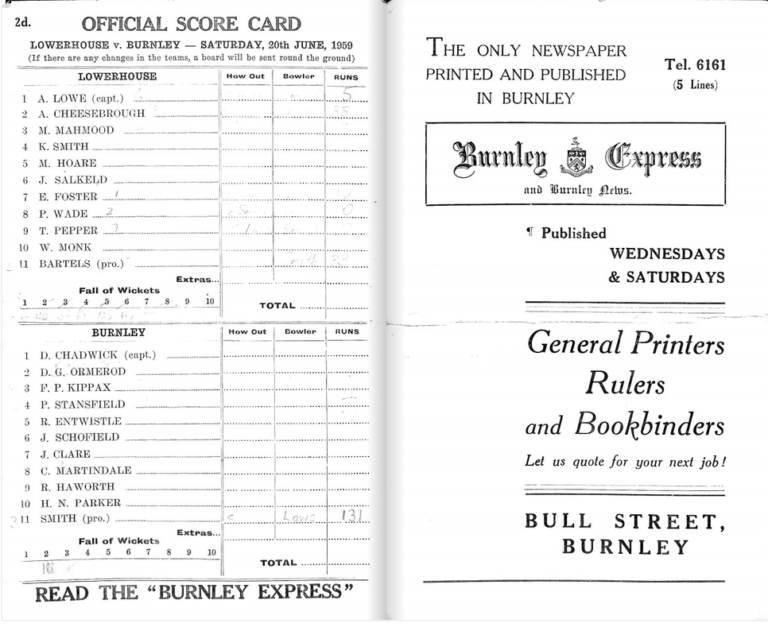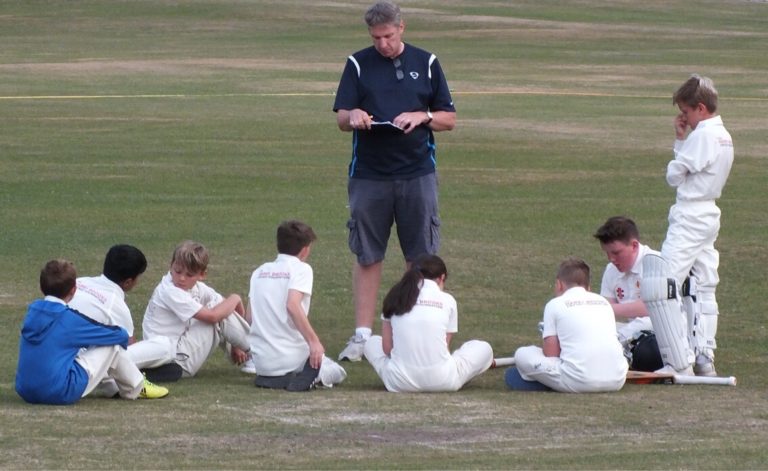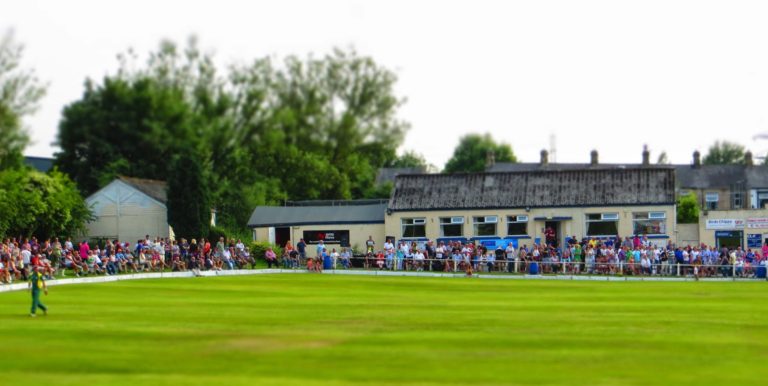160 Years – Tommy Shutt – The Story of a Lowerhouse Legend
Background and early years
Tommy Shutt’s story starts with his parents, William Shutt and Sarah Holden living in Lowerhouse in the second half of the 19th century.
People were coming into Lowerhouse village from all over to work in the textile industry, often living in overcrowded, insanitary conditions. The Shutts came from the Colne area and the Holdens from Marsden (Nelson), although Sarah’s mother was actually born in London. The 1861 census shows that Sarah was a single woman of 20, living with her baby, Richard, her sister and her parents, at Lowerhouse Gate, also known as Lane End, a cluster of dwellings near the Bird I’th’Hand pub which can be seen in the background on this image. The pub was renamed the Lane Ends around 1884 and was demolished and replaced by the current building in 1926. 1
William was living with his father and 7 siblings in Lowerhouse Fold which included a row of back to back houses where the green is now.2
William Shutt and Sarah Holden were married at All Saints Church, Habergham on 31 January 1863. William signed his name on the marriage certificate, but Sarah and their two witnesses just put an X, being unable to write and probably unable to read.
William and Sarah had a further 9 children, of whom only 4 boys and a girl survived infancy, Tom, born in 1875, being their third eldest surviving child. Sarah’s son Richard Holden went to work in the mill at 10 years old as a doffer, replacing full bobbins with empty ones on a spinning machine, a job usually done by young boys as it required speed and dexterity. In the 1891 census, Tom, aged 16, was a weaver, but he and his brothers would have all started work at 10, like these boy workers at Lowerhouse Printworks in the 1880s.3
A brotherhood of cricketers
When Tommy started playing cricket he was following a well trodden, if quite short, path across Lowerhouse Lane. Tommy’s half brother Richard Holden started the procession around 1880, followed in age order by his three youngest brothers, William, Tommy and Albert. For a time around 1894 Richard, William and Tommy were all in the first team together, and in 1895 Richard won the batting prize, Tommy won the bowling prize, and William won the second eleven bowling prize.
Richard was a good cricketer, playing for some 20 years until 1900. The League did not start until 1892, so his stats. on the Lancashire League website are only for the last 8 years of his career, when he was in his late thirties. He scored the very first League hundred by any Lowerhouse amateur, when he got 110 not out against Bacup at Lowerhouse on 1st August 1896, despite the best efforts of the aptly named James Bowler, Bacup’s pro. Richard Holden died aged only 44 in 1904. He worked as a stripper and grinder, an engineering job in the textile industry which involved maintaining the metal teeth on carding machines, which perhaps contributed to his death from “an internal complaint”. He is acknowledged as one of the club’s best early players in the 1914 Bazaar programme. Richard had been Lowerhouse captain, and a committee man so must have been a big influence on his brothers, particularly Tommy.
Tommy’s cricketing adventure begins
Tommy made his League debut for Lowerhouse C.C. in 1893 at the age of 18. Nowadays that wouldn’t be regarded as particularly young but in Victorian England the watchwords were more ‘seniority’ and ‘deference’ rather than ‘prodigy’ or ‘meritocracy’. For a player who would go on to play 401 games for Lowerhouse and many more (mostly as a pro’) elsewhere, it was an underwhelming start. He played just 7 matches scoring 28 runs (high of 16) and wasn’t asked to bowl.
Tommy was primarily a bowler and as such was open to being a victim of the League’s two professional rule which existed between 1892 and 1899. An amateur bowler’s career could easily be derailed by lack of opportunities as the paid men dominated. The best example of this was Billy Fenwick at Ramsbottom. He averaged about 30 wickets a season through the ’90’s but in 1900, when he got a fair chance, took a League amateur record 137 wickets. This might have been a freakish year but he still got 71 victims in 1901.
At Lowerhouse in 1894 Tommy got limited chances, as the professionals Brown and Hardy got the bulk of the overs. Shutt, though limited to 30 overs, showed his future promise taking 14 wickets at under 11. In 1895 Tommy got a crucial break. A.E. Berry joined Silas Hardy as the ‘second’ pro’. His skills were more in batting and Shutt’s bowling role became important within the team. He took 55 wickets and also showed he could contribute with the bat, making a maiden half century at Accrington. Tommy had arrived and there was even a proud appearance for Lancashire Seconds.
Turning Pro. and leaving home
Shutt’s efforts were such that he was offered and accepted the pro’s role at Stalybridge C.C. for the 1896 season. They were a club who played friendly games against the likes of Ashton, Dukinfield and Glossop. The club joined the Central Lancashire League in 1898 and stayed there until resigning in 1916. Tommy proved a popular player. He sometimes played alongside Arthur Wharton the first black player to play in the infant Football League, who was playing for Stalybridge FC. Wharton was a great all-round athlete excelling at multiple sports.
Shutt’s achievements got the attention nearly 300 miles away of Perthshire C.C. It’s intriguing in an age of no internet, television, or even radio and telephones, how players were scouted from so far away. Probably newspapers and old-fashioned letter writing were to the fore. Tommy Shutt had a two year stint playing his home games in the city of Perth. That settlement is sometimes described as the smallest Scottish city because it fits between two inches. The North Inch and the South Inch are two large areas of parkland on either side of the city and Shutt played home games on the former.
The 1897 Perthshire CC team with their professional, Tommy Shutt, standing far left, in front of the pavilion which Suffragettes burnt to the ground in 1913 in a campaign against male strongholds. 4
Tommy enjoyed his batting, getting a century in each of the 2 seasons. In 1897 he made a club record 164 versus Watsonians and a year later a 3-figure score against Glenalmond. Tommy’s batting was never consistent but could be quite brilliant when it was his day. Tommy was a successful bowler for his team taking 154 wickets over the two years. Although we don’t think of this area as ripe cricketing territory the games drew large crowds particularly when local pride was at stake. Tommy received £4 pounds per week which would be over £500 now and his benefit game raised £61 pounds. This gave the working class lad from Lowerhouse a nice nest egg of the equivalent of over £7,000 pounds to return home with. Given his popularity and fine play it was a surprise that Tommy wasn’t retained, and in 1899 Perthshire didn’t have a good experience with their new professional, and may have regretted the parting of the ways.
There was a job closer to home for Shutt as he re-joined Lowerhouse to be their second pro’ alongside the Notts fast bowler Ben Gregory. He wasn’t found wanting, largely outplaying his fellow ‘House Hall of Famer. Gregory took 72 wickets and scored 153 runs whilst Shutt had 81 and 362 respectively. Given those stats it’s surprising that it would be the Notts man who retained his role for 1900 when there was to be a sole pro’ at each club. One newspaper report said Tom had gone back to Lowerhouse in the hope of being called up by Lancashire. Also, Tom’s father William, had died in April, 1898, which may have been a factor in Tommy coming home.
It’s possible that Tommy was offered the pro’s job at Lowerhouse but chose to get back on his travels. This time to the scenic home of Hawick C.C., in the Scottish borders.5
The main sport there is rugby union and the town have provided numerous Scottish internationals. Later the town was the home of one of the greatest and iconic of B.B.C. sports commentators, Bill McLaren. Nevertheless, cricket is a popular summer sport and towns such as Jedburgh, Selkirk, Kelso and Galashiels have excellent cricket facilities
It must have been frustrating for Tommy that some of the fixtures were amateur only, especially given the many bowler-friendly wickets. He was able to take 64 wickets at under 6 but it wasn’t enough to stop the league’s powerhouse clubs Selkirk and Galashiels from dominating proceedings.
In August 1900, Hawick played Langholm, whose ground was on the estate of the Duke of Buccleuch. The Duke had several homes, and Langholm Lodge6 was mostly used for the grouse shooting season.
Tommy skittled Langholm out, in the presence of the Duchess and members of her family, and then the Duke’s son “entertained the teams in a marquee on the ground.” (Food, not song and dance.) Quite an experience for the Lowerhouse weaver.
Hawick could not afford to pay a pro for 1901, so Tommy’s cricketing journey then took him to the Liverpool and District Competition for 1901 and ’02. He signed for the Northern Club then based at Waterloo Park in Sefton. By 1907 they had found a permanent home at Moor Park in Crosby. About a century later one Stephen Parry emerged at the club, went on to play for England and in a nice co-incidence, become the 2021 Lowerhouse C.C. professional. Although Shutt took 50 wickets at under 9 in 1901, his adopted team finished tenth out of eleven in the standings. Strangely his slightly poorer ’02 season with 48 wickets at 12 saw a decent mid-table finish. He also played a couple of mid-week games in August, 1902 for Burnley Police, so must have joined the force around then.
Love and Marriage
Not many months after joining the force, Tommy married Alice Iveson of Bear Street, whose family had come to Lowerhouse in the 1880s, originally from Hawes. They may have been courting for some time, they were the same age and were both weavers at 16. However, her mother died when Alice was 18, and the youngest child, George, was still a baby. Alice was the only adult daughter in a family of seven boys and two girls, so she had to take over domestic duties. Five years later, her father also died, making her the head of the household. By the 1901 census, only her older brother William had left home and she was still looking after seven younger siblings. However, they were now all working except 9 year-old George, and even he would be able to go to work when he was 12. So with her responsibilities easing, and Tommy having given up the Summer job and settled down as a policeman, they were married in Spring 1903 at All Saints’. They were both in their late twenties. Their only child Victor was born in 1904.
P.C. Shutt
When Tommy joined the Police in the summer of 1902, perhaps not co-incidentally, H.C. Rawe, the Chief Constable, was a very keen cricketer, who just that summer had set up a cricket league with neighbouring forces. Tommy was the star of the cricket team, helped organise the Police sports day, and competed successfully in the Police swimming gala. All of which may have helped his promotion to Detective Officer. However, the Borough Watch Committee, who were in charge of Policing, felt that the Police should be concentrating on fighting crime and in March 1905 Chief Constable Rawe resigned before he was sacked, whereupon the Watch Committee disbanded both the cricket club and the Police brass band.
A brief detour across town
It was probably the connections he made in the Police which led to him deciding to play at Turf Moor in 1904 as an amateur. This caused a little consternation in the Lancashire League and in one nearby village in particular! Burnley only finished ninth that season. Shutt’s return of 38 wickets was only satisfactory at best especially after his great start, taking 7-15 in his second match versus Enfield. Tommy scored over 500 runs but it may have been one of the most weirdly distributed run totals in League history. He scored 284 runs in two games against Rawtenstall and just 222 against the rest of the Lancashire League! At the Worswick Memorial Ground he scored 164 out of the visitors’ total of 227. A bemused and disheartened Rawtenstall were 25 all out in a totally abject reply. This century was a League highest by any Burnley player and remains as high as third to this day. Tommy made a mere 120 in the return game! How the Rawtenstall team must have been sick of the sight of him. With that second century, Tommy also passed 1,000 career league runs and earned himself a prize of two guineas offered by the Mayor, Alderman Carrington, at the Burnley C.C. Annual General Meeting.
Home again
In 1905 Tommy’s brief flirtation as a Burnley player was over and he came back to Lowerhouse, albeit restricted by still being a policeman. He was 30 years of age and had taken just 150 wickets for his home club, a long way from the 1,000 he later achieved. It was a low key return and Shutt took 36 wickets in the 19 matches he played. There was, though, an incredible batting highlight at Bent Gate, Haslingden. Tommy scored 173 not out in a convincing ‘House win. It is even more special in that ‘six’ hits weren’t awarded in those days. This score stood as a club record (pro’ or amateur) for 113 years until Ben Heap made 175 at home to Great Harwood in 2018.
Before 1906, Lowerhouse had struggled on and off the field to be a competitive and relevant club but starting that season they would have six consecutive top half finishes. Tommy Shutt led a strong amateur line-up, perhaps the best of the 20th century. Elliot, Cook, Walker and the two Whittakers are all in the club’s Hall of Fame. Tommy took 64 wickets in ’06 with a best of 8-25 and the club achieved fourth place. The only downside was that rivals Burnley won the first of a hat trick of Championships. B.C.C. was said to be Bell, Cook (pro’) and Cudworth, the team’s star players. If Lowerhouse had only had Billy Cook for four seasons in this period rather than after the War, when their batting was terrible, then history might have been crucially different!
Tommy left the Force at the end of 1906 and Lowerhouse announced that he would be available full time for the 1907 season. In 1907, Shutt set an amateur bowling record with 74 wickets and the club were fifth in the standings. In 1908 he bowled his highest number of overs for the club but the wickets were slightly down at 65. A fairly lacklustre batting year saw him get under 200 runs with a high of 33.
The team took a step backwards in 1909 finishing seventh. Tommy’s batting highlight was a century at Enfield but although he took two more wickets than pro’ Billy Tolson, his haul of 54 was nothing special by his own high standards.
1910 – a very good year
1910 was an excellent season at Lowerhouse. Only the near miss of the 1982 season being better in the 20th century. The club were joint second with Burnley and Rishton, with only Colne ahead. Tommy had a great bowling season beating his own club record with 76 victims, that record has survived now for over 110 seasons, despite close calls by Billy Whittaker, who took 71 wickets in 1916 and Jim Minhas, who bagged 72 victims in the 1956 season. Given the bowling restrictions now it won’t be under pressure any time soon. The highlight for Tommy was his performance in the home match versus East Lancashire. He scored a fine 113 not out with the bat and followed it up with 6-23. All 6-23’s are good but one that doesn’t rely on fellow fielders or an umpire’s fickle finger is especially so. That day Tommy had four cleaned bowled and two caught and bowled.
This image from the Lancashire Evening Post, June, 1910, catches a moment of live action, unfortunately it shows Tommy playing on to Dick Steeples, Todmorden’s pro. Tommy had the last laugh though, taking 6-26 in a devastating spell of 9 overs, to give Lowerhouse a 52 run home victory.
Off again, to Rishton and Read
The publicity of Shutt’s form led him to being installed as Rishton pro’ for the 1911 season.7Lowerhouse did well to cope without him, finishing a strong fifth to Rishton’s tenth. Rishton worked their 36 year old pro’ hard and he took his best ever aggregate of 82 wickets. His batting was its usual inconsistent self but he did make what would be his last ever hundred. Ironically it came against Lowerhouse at Liverpool Rd! Shutt wasn’t re-engaged by Rishton who chose Yorkshireman John Newstead instead. You couldn’t argue with the results of that decision. Newstead took 94 wickets and scored 554 runs and the Blackburn Rd. outfit were 1912 Lancashire League Champions.
Meanwhile in February, 1912 Shutt signed for what would be his last professional engagement. This was fairly close to home at Read of the Ribblesdale League. The team struggled in a season of generally poor weather conditions and finished third bottom. Tommy, though, had some great individual performances. In the two games against eventual champs Burnley St Andrews, he got a 67 with the bat and a 6-83 respectively. His seasonal best bowling was 7-25 versus Clitheroe. His last pay day was an end of season benefit match against Darwen.
Home again, to stay
Tommy returned to Lowerhouse in 1913 and would remain there until his cricketing retirement. In that season he showed the fire still burned and not for the first time out bowled his pro’. taking 63 wickets. In the year of the outbreak of World War One, Tommy and the club had a season to forget. Just 39 wickets was not the Shutt-like standard and he also didn’t get over the thirty mark in batting. Lowerhouse finished rock bottom. The standards the team had set from 1906 to 1911 would not be repeated until the 21st century.
Lowerhouse were a respectable sixth in 1915 albeit well behind an Accrington side with a dominant bowling attack. Tommy’s 20 wicket total was his worst since his restricted chances as a 19 year-old way back in 1894. In hindsight it’s strange that the league limped on into 1916. There were no professionals engaged and so many of the younger and better players were serving overseas. The league would be suspended by 1917. Shutt took 45 wickets in ’16 but given that it was 25 less than Billy Whittaker, who he usually outshone, it may have been a half-hearted effort reflecting the mood of the cricket competition and the country in general.
However, there were no thoughts of retirement for Tommy when the Lancashire League returned in 1919.
Lowerhouse had signed the legendary Billy Cook as pro’ but were hampered by him having injury issues which left him playing only 50 per cent of the season. Tommy was approaching his mid-forties but was still willing to be a workhorse for his team. He took 45 wickets and showed that his batting talents hadn’t totally waned. His highlights were 63 at home to Haslingden, 44 versus East Lancashire and 49 not out when Bacup were the opposition.
A loyal servant to the end
So to 1920 when, given his advanced age, he had a truly great year with his bowling. A return of 68 wickets was his best for a decade. He clearly enjoyed bowling in tandem with the brilliant Cook. Even though the batting was very thin, the team finished a very worthy fifth. Tommy’s best day that season was at Enfield where he took 4-38 and scored his seasonal best with 67 runs which must have impressed Enfield’s Eddie Paynter, 27 years his junior. Further down the road, Paynter, then 18, would become a legendary English Test star, particularly for getting out of his sickbed in the ‘Bodyline’ series and saving the Brisbane Test.
The League would sometimes allow clubs to allocate a game as a benefit match for a long serving amateur and Tom was the beneficiary of Lowerhouse v Colne on 17th July, 1920. On 3rd July 1920, the Burnley News printed a long piece on Tom’s outstanding career. The report tells of Tom’s 27 year cricketing career, his 17 years’ association with Lowerhouse, and his “record of consistent and devoted service which deserves the fullest recognition” so all local cricket supporters were urged to show their “appreciation of one who has always been a good sport and popular on every field.” Unfortunately, the weather was poor, although the gate of £32 plus ticket sales, was described as not bad under the circumstances. Tom had been out for a few weeks with a sprained ankle, and opened the Lowerhouse innings with a runner, scoring 15 out of Lowerhouse’s 104. The outstanding performance was by Colne’s pro Denis Hendren who got 9 wickets with the tenth also being a run out off his bowling. Colne only managed 72 in reply with Lowerhouse pro Billy Cook taking six wickets and Tom himself picking up three wickets.
In 1923 Tommy’s fitness and commitment were still there and he bowled over 200 overs in the season taking a respectable 43 victims. Even in 1924, his last full season, Tommy was the leading bowler with 48 wickets, beating pro Jack Cuffe’s 44, his efforts not daunted by the team’s last place position. The highlight for Shutt was in the Cup quarter-final at Burnley. Lowerhouse were dismissed for 92 but with Tom to the fore, the home side were a lowly 44 all out. (Shutt 5-18). Unfortunately the team lost narrowly by 3 wickets in the semi-final over at Thornyholme Rd. Accrington.
1,000 wickets at last
It is quite possible that Tommy’s high workload was down to a quest to get to the remarkable 1,000 wicket mark before ending his marathon career. In 1925 he was just 18 wickets short and had probably decided to end his career when the target was reached. On June 20th at Alexandra Meadows, he got 3-45 to leave him on 999. The next game was on the following Tuesday at home to Haslingden. There were no Sunday games until the 1960’s and each club had a couple of midweek games to get the fixtures completed. It was in this low key game, the only Lancashire League game played on that date, that Shutt got the Haslingden pro’ Frank Edwards out for 22 to reach his celebrated 1,000 mark. It was fitting he’d dismissed the opposition professional to end his quest as it had started 31 years before, when Church paid man Tom Flowers had been his first ever wicket. It wasn’t his last match, as he played at Turf Moor on June 27th. He batted at 9 and scored 9. He was then able to put his feet up as far as bowling was concerned as his Lowerhouse team mates gave him the fairy tale ending of an 81 run clear cut victory.
After 33 years of blood, sweat and toil it was all over and he could rest his weary frame.
Other life events, 1907 – 1952
It was probably when he left the Police Force, that Tommy and Alice first went into the pub trade, rather fittingly taking over The Cricketers Arms at 108 Lowerhouse Lane, a little old pub that survived until 1985. Tommy probably made a good landlord, this advert. in the 1910 League Handbook8 promises “cricket chatter.” Alice however was a Methodist so might not have been quite so comfortable.
The following season according to the 1911 census Tommy was back weaving, and according to the 1921 census, he was working for Butterworth and Dickinson’s, textile machinery manufacturers, Rosegrove, as a machine moulder.
At the end of 1930 he and Alice took over the Victoria pub in Padiham. Then tragedy struck. Victor Shutt died suddenly, in March 1931, aged only 27, leaving a widow and young son. There was a flu epidemic at the time and his death was said to be from pneumonia. The whole village was devastated. The Shutts left the Victoria in 1933, moving back to Lowerhouse, Tommy was reported to be “advising” the struggling second eleven.
In July 1939 Alice died at their home, 232 Lowerhouse Lane, they had been married nearly 40 years. Also in 1939, aware that war was imminent, the government compiled a register of the population, to help with issuing ration cards etc. Perhaps for the first time in his life, Tommy was living alone, a retired machine moulder. We don’t know how he spent the war years. We do know that in April 1946, aged 71, he married the landlady of the White Horse in Padiham, Ethel Boocock. Ethel, who had been in the pub trade for many years, took over the licence on the death of her husband in 1942. That White Horse was a very old pub, which was replaced by a new one in the late sixties, now closed although the building remains.
The end of an innings.
Tom died on 29th January 1952 aged 76. Sadly, his death merited only the briefest of obituaries in the Burnley Express and the death of King George VI a week later, meant any idea of a follow-up tribute will have been forgotten. By the time the death notice appeared in the Express on 2nd February, he had already been buried, but let’s hope that Lowerhouse gave him a good send off. There were initially a lot of Lowerhouse Shutts, but after the disruption of two world wars, along with huge changes in every walk of life, if there were any left, they were no longer concentrated in Lowerhouse. Tommy had only one direct descendant, Victor’s son, John, born in 1927. His widow Ethel died in 1961.
Tommy is buried with Alice in his family grave in the All Saints’ graveyard. The grave is rather neglected but the headstone is still standing and its poignant inscription is still legible. Tommy’s name was never added.
Close by is the grave of his half-brother, Richard Holden with its decorative headstone.9 10
Epitaph
In conclusion Tommy Shutt is the most talented and significant cricketer to be born in Lowerhouse. For Lowerhouse he has the record of 1,000 career wickets (over 400 clear of second place) and the best two individual amateur seasons in club history with 76 and 74 wickets respectively. He took five wickets in an innings 69 times for Lowerhouse. He also plied his cricket outside Lowerhouse, from Perth to Stalybridge and Hawick to Read and was successful and popular wherever he played. He had over 500 wickets in the years he didn’t play at Lowerhouse.
In batting he scored 4,687 runs at Lowerhouse which was just 24 short of the record at his time of retirement. It is still tenth placed after nearly another hundred years. As a bowler he was somewhere between excellent amateur and serviceable professional. He was never express pace and relied on skill and later craftiness and experience to get the better of the opposition. Although always a consistent bowler, his fascination to us, a century on, is more the batting side of his game. He can only be described as an erratic and enigmatic performer. He scored six Lancashire League centuries but only averaged 14. He scored the second highest ever score by a Lowerhouse player and the third highest by a Burnley player, but got 52 ducks for Lowerhouse alone. Did he have too much of a devil may care attitude or a cavalier style, or perhaps he was just extremely vulnerable at the start of his innings. And finally, there have been approx. 25,000 innings by Lowerhouse players in Lancashire League history and the same number at Burnley C.C. Out of those 50,000 innings,11 Tommy has two of the top five highest ever scores. Not bad at all for a player whose batting was his secondary talent!
What a cricketing life he led for someone from the most humble of circumstances and the club will surely not see his like again. Lowerhouse C.C. salutes one of its own, and one of its finest.
Authors: Paul Hargreaves and Anne Cochrane, Lowerhouse C.C., 2022
Tommy Shutt’s Lancashire League Statistics
Acknowledgements/Sources
Lancashire League stats. and information from the League website http://lancashireleague.com/
Other sources the British Newspaper Archive, Find My Past, All Saints’ on-line Parish records, Burnley Library, LHCC archive.
1 Image of old Lowerhouse, Burnley Central Library at https://redrosecollections.lancashire.gov.uk
2 Image of Lowerhouse Fold sourced on internet, uncredited
3 Image of boy workers from the Drew album, courtesy of Mike Townend, curator, Towneley Hall
4 Image of Perthshire CC team of 1897, 5of Hawick CC and 6 of Langholm Lodge courtesy of Richard Miller
7 8 Images from Lancashire League Handbook 1910 and 1911 https://crickethistory.website/
9 10 Photos of the Shutt and Holden graves by the authors
11 This super-stat was achieved by multiplying the number of league seasons by the average number of innings in a season, the latter figure obtained by looking at 10 seasons down the decades and taking an average.
















